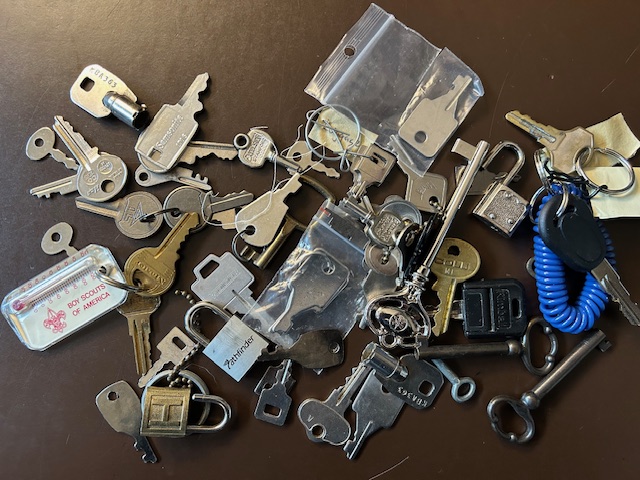By Peter Pavarini

The Assyrians invented the first lock and key approximately 6,000 years ago.[i] Made entirely of wood, the primitive device used a pin-tumbler system similar in design to today’s locks. The Egyptians later improved this prototype, and the concept spread to ancient Greece and the Roman Empire.[ii] The modern pin-tumbler lock, which is still used today, was invented by Linus Yale, Sr. in 1848 and refined by his son Linus Yale, Jr. in the 1860s.
What I Learned from a Flat Tire
On a recent trip to our home in the Blue Ridge Mountains, my wife and I had a flat tire driving through a construction zone associated with last year’s hurricane. Because of a security feature on our late model SUV, what should have been a routine tire repair turned into a 3-day nightmare. After the car’s onboard computer warned us that one of our tires was rapidly losing pressure, we immediately drove to the nearest auto service shop expecting to have the tire repaired promptly so we could be on our way.
The shop owner threw me a curve, however. He said he wasn’t able to remove the troublesome wheel because it was secured by a locked bolt requiring a tool he didn’t have. In my many years of car ownership I never heard that excuse. The sympathetic fellow explained that many high-end cars now have this security feature to prevent the theft of their expensive alloy wheels. As someone who almost never goes into high-crime areas, I couldn’t believe we had unknowingly purchased a vehicle resistant to being found up on cinder blocks one evening.
To make matters worse, the only car rental company in this small rural town was completely out of cars. The gracious tire shop owner offered to call a tow truck operator and have us taken to the nearest dealership 65 miles away. Hopefully, that dealership had the special tool needed to remove the wheel. Obviously, we had no choice. After negotiating a $400 fee to have the car towed to the dealership, we experience the novelty of riding with our dog in the front seat of a large tow truck over winding mountain roads.
A Brief History of Securing One’s Possessions
Not too long ago, few people locked their doors except when they were away on vacation. Even in the suburbs of New York City where I grew up, no one imagined a day when we’d be dealing not only with stolen car wheels, but also the theft of personal identity, home titles, private medical information, and every other type of scam.
Of course, the need to protect oneself from wrongdoing has been around since Cain slew Abel. After a cave no longer provided an adequate safe space, our ancestors began sharpening sticks and stones into lethal weapons. That weaponry was later enhanced by the domestication of wolves who unwittingly became our first home sentries. When even those measures failed, wealthier individuals began hiring armed guards, erecting watchtowers and lookouts, and building walls and alligator-filled moats to secure their prized possessions and loved ones.
According to legend, Ben Franklin invented the first modern home security system. It was no more than a small mirror, called a “busybody mirror”, attached to a window on a building’s second or third story. The device allowed the homeowner to see who was at their front door without anyone realizing they were being observed. Franklin purportedly used this security measure to slip out the back door whenever his mother-in-law came to visit. A few of these devices can still be found attached to homes in Philadelphia’s historic district.
By the mid-Nineteenth century, electricity was incorporated into a variety of devices protecting people and their property. A New Hampshire electrical engineer by the name of Moses Farmer developed a way to open and close circuits with an electromagnet causing a bell to ring. Augustus Pope, a Boston minister, combined Farmer’s device with a mechanism which a home intruder would trigger, resulting in the first electronic home security system. William Channing, a Harvard University student, took this idea one step further by using the recently invented telegraph to set up a citywide system for alerting police and firemen of home emergencies.
The home security industry took off from there. Over the next century and half, monitored security systems became commonplace but increasingly more dependent upon passwords, biometric scanning, and video surveillance to operate. And yet, no matter what we came up with, the bad guys always seemed to be a step or two ahead. Which brings us to the current day.
What We Give Up to Feel Secure
One must wonder whether 24/7 electronic monitoring and its numerous rules and protocols for accessing our personal data and equipment actually make us more secure. We’ve become resigned to living under the “lock and key” of password generators, 90-day password change requirements, multi-factor authentication methods, and the presumption that anyone who wants access to anything of value is a thief. What level of freedom have we sacrificed to safeguard our stuff?
In his psychological thriller, The Man Who Was Thursday, G. K. Chesterton wrote:
“Thieves respect property. They merely wish the property to become their property that they may more perfectly respect it.”[iii]
At a time when a small but loud minority of Americans are flirting with the idea of abolishing private property, it’s appropriate to remember where our property rights originally came from. The Founders of this Nation were deeply influenced by English legal history. Before the Magna Carta in 1215 and the Declaration of Rights in 1689, the British monarchy had plenary authority to seize personal property and put people in jail at whim. Indeed, it was the abuse of the colonists’ property rights, namely taxation without representation, that prompted the American Revolution.
Samuel Adams succinctly explained why Americans believed in an inherent right to the ownership of private property not under the control of the government:
“Among the natural rights of the colonists are these: first, the right to life, secondly to liberty, and thirdly to property; together with the right to defend them in the best manner they can.”[iv]
From the beginning, Americans viewed property as much more than the ownership of land. Not only were their houses, livestock and other material things protected, but also immaterial things like conscience, creative thoughts, reputation and future profits from the sale of an existing thing or idea. Indeed, half of the Bill of Rights relates to this broad definition of property.
James Madison, a key contributor to the Bill of Rights, believed property rights were essential to protecting all other freedoms in the new Republic. Madison wrote that the security of property was essential to personal growth and responsibility because it allowed individuals the ability to make their own decisions about their lives.[v] In effect, liberty was meaningless if the government was permitted to take anything from anybody at any time.
Even before the American Revolution, the wealthy and upper classes of society had the means to protect themselves from thieves and scavenging animals. It was the poor, working and middle classes who still needed to have these protections in our new constitutional system. Consequently, the Third and Fourth Amendments assured freedom and security of one’s home and possessions. The Fifth Amendment guaranteed due process and just compensation when the government attempted to seize one’s property. The Seventh Amendment addressed the right to a jury trial in common lawsuits involving more than twenty dollars, and the Eighth Amendment protected citizens from excessive fines.[vi]
Restoring the Moral Core of American Society
None of these legal protections would have been necessary had everyone obeyed the Biblical commandment found in Exodus 20:15 and Deuteronomy 5:19 – “Thou shall not steal”. That moral prohibition was not just a Judeo-Christian principle, but it was also found in the tenets of Islam, Hinduism, Buddhism and other belief systems.
But the temptation to take what does not belong to you has remained a perpetual problem worldwide. Consequently, civilized people throughout history have sought to discourage such misconduct and punish those who are not easily discouraged. Arduous verification protocols and locked alloy wheels are just two examples of what we reluctantly accept to live in the material world.
Such restrictions on our freedom might be tempered by residing in a small town or rural area, but unless one is willing to live “off the grid”, they are impossible to avoid completely. What’s really needed is a revival of the communal trust we had when we all knew our neighbors, co-workers and those we did business with. Just the shame of being accused of thievery or other acts of dishonesty was enough to stop most of us from misbehaving.
Restoring such a high level of trust will require more than tweaking our political or legal system. It can only come from a systemic change in culture, not unlike the revolutionary forces that gave birth to our Nation nearly 250 years ago.
[i] A rudimentary wooden pin lock was discovered in the ruins of Ninevah, the capital of ancient Assyria.
[ii] The Romans improved these ancient devices by making them out of bronze and iron and introducing more sophisticated key designs.
[iii] G.K. Chesterton, The Man Who Was Thursday: A Nightmare, Watchmaker Publishing (2010).
[iv] Samuel Adams, The Rights of the Colonists, Report of the Committee of Correspondence to the Boston Town Meeting, November 20, 1772.
[v] The Papers of James Madison. Edited by William T. Hutchinson et al. Chicago and London: University of Chicago Press, 1962–77 (vols. 1–10); Charlottesville: University Press of Virginia, 1977.
[vi] See “What Is Property? Why Protect It?” from Preserving the Bill of Rights, The Bill of Rights Institute, https://billofrightsinstitute.org/curricula.

Be First to Comment